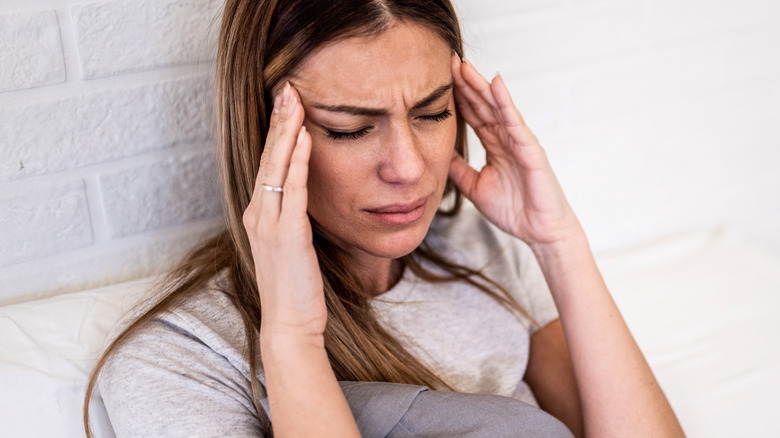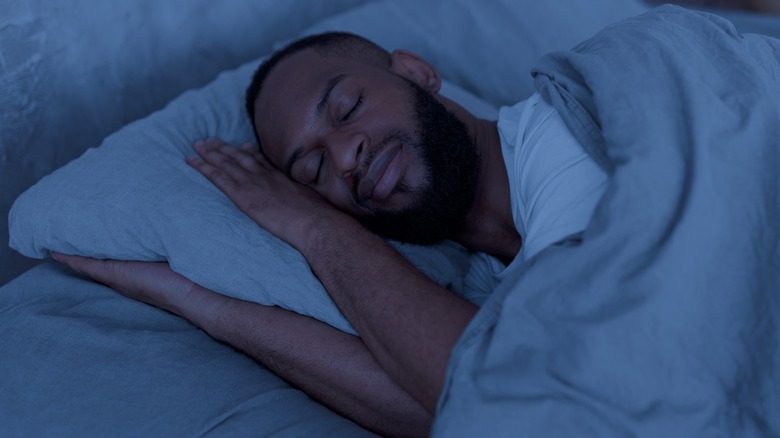This Is The Best Sleep Position When You Have A Headache
A headache, no matter how dull, can be uncomfortable. It can keep you from being able to get through your day as you would normally, and it's certainly not easy trying to fall asleep with one. But as it turns out, there are sleep positions that can both aid and disrupt your goal of getting rid of headaches.
According to experts, sleeping on your back or on your side — where your neck is well supported and your spine is neutral — is the ideal sleep position for when you have a headache. The idea is to not put undue stress on your neck or back as you go to sleep, as this can exacerbate the problem. So all you stomach sleepers out there may have to switch things around if you're trying to go to sleep with a headache. "Sleeping on your front can cause headaches as your back is arched," explained Dr. Mariam Adegoke, GP and founder of Adegoke Wellness Clinic (via Marie Claire). Your neck is stressed in this sleep position too, as you might turn your head to the left or right to allow yourself to breathe through the night, and this can twist your neck into an uncomfortable position.
How are headaches and sleep connected?
When it comes to migraines, your sleep schedule and how you sleep can be more important than ever. "Anything that gets you out of your normal routine can cause a headache, because the 'migraine brain' likes to be as steady and stable as possible," explained Dr. Katherine Hamilton, a neurologist and headache specialist at MedStar Health in Washington (per Everyday Health). This involves maintaining good sleep hygiene and building healthy habits around your sleep schedule.
Restricting blood flow to your head or twisting your spine and neck into uncomfortable positions at night can all contribute toward waking up with a stress headache or making an existing headache worse. And it's not just your head that's going to feel awful. Your neck, shoulders, and arms can feel stiff, too.
Curling up in a fetal position might feel comforting, but it can make matters worse. By pushing your shoulders forward and crouching your neck around your legs, you're putting stress on your neck and arms. Are you a fan of placing your arm over your head when you go to sleep at night? This can cut off the circulation of blood, contributing to a headache. Your bedding, particularly your pillow, also plays a part, according to Dr. Mariam Adegoke (via Marie Claire). "Pillows minimise any stresses or pressure on your neck that lead to compromise of pain-sensitive structures, which in turn cause waking symptoms such as neck pain and stiffness, headaches, shoulder or arm pain."
Other sleep tips for going to bed with a headache
You can start by making sure you're getting enough sleep consistently. The recommended number of hours for adults is anywhere between 7-9 hours. Also, try to maintain regular sleep times. This is especially important for those who have migraines. If you're tempted to take a nap in the afternoon, think twice about it, or at least don't go overboard. Making sure you're sleepy enough to go to bed at the usual time is an important part of avoiding headaches.
Invest in good bedding (pillows, mattress, etc.) that will help you get a comfortable night's rest. Make sure your bedroom is cool, quiet, and dark, and turn off digital distractions a few hours before you drift off. Don't consume any large meals too close to bedtime, and avoid caffeine and alcohol too. Journaling before bed, deep breathing exercises, some light yoga, and meditation are all simple things you can incorporate into your nighttime routine if you want to feel great tomorrow.
It is also important to notice the signs your headache is more serious than you think. Mental health conditions like depression and anxiety, sleep apnea, thunderclap headaches, and even meningitis can be causing your headaches. Thunderclap headaches come on suddenly and peak at 60 seconds (via Mayo Clinic). They could be indicative of bleeding in the brain, so seek immediate attention if you feel this kind of pain. Sometimes you need the help of a professional to get to the root of your headaches before you can even begin to treat them.



